A number of companies have, as of late, been testing the potential of using electric vehicles (particularly, their charging systems) as part of energy management systems.
And now, it appears that Nissan has decided to get on that wagon as well — recently announcing that it was participating with other businesses and government authorities in Japan in the testing of a new “demand response” energy supply and demand system.
The new system aims to utilize electric vehicle technology to aid power grids in the management of peaks in demand. Ideally, this would ensure power supply during disruptions (disasters, etc), and also, possibly, aid in the storage of energy production peaks from renewable energy sources.
Nissan is currently utilizing its LEAF EVs and its “LEAF to Home” power supply system in field tests — demand response testing at several of its sales outlets run by subsidiary Kanagawa Nissan. The actual tests are being done by ENERES corporation.
The recently started project is partly the result of the conventional approach receiving increased scrutiny after some of the power supply issues that followed the earthquake disaster in 2011 — with the goal of making energy grids more efficient through the modification of consumer power consumption via consideration of available energy supply.
The press release from Nissan provides more:
Under the demand response scheme, power companies request aggregators to use energy conservation measures, and they are compensated for the electricity that they save.
Usually when energy-saving is requested consumers may respond by moderating their use of air conditioning and lighting. However, by using the storage capacity of electric vehicles and Vehicle to Home (V2H) systems, consumers can reduce their use of power at peak times without turning off lights and appliances. This is particularly useful in commercial establishments where it is difficult to turn power off to save electricity.
The demand response scheme involves assessing the usefulness of energy-saving measures using V2H systems during peak-use periods and analyzing the impact of monetary incentives on business. For example, the testing involves a LEAF and LEAF to Home system which is connected to power a Nissan dealer’s lighting system during regular business hours using stored battery energy. This reduces electricity demand on the power grid. The aggregator is then compensated for the equivalent of the total amount of electricity that is saved. Two or three tests per month will be conducted on designated days for three hours’ each time sometime between 8am to 8pm from October 2014 through January 2015.
As you can probably easily guess, more effective means of managing energy networks means a greater ease of integrating renewable energy supply into the grid. Something certainly worth working towards.
A very similar program is being implemented in the US right now as well — relying on direct communication between utility companies and EVs, via the cloud. It was unveiled by a coalition of some of the world’s biggest automakers — Ford, BMW, Honda, GM, Chrysler, Mercedes-Benz, Mitsubishi Motors, and Toyota. These automakers are, again, aiming for the new communication system to eventually allow for greatly improved grid stability.
Source: CleanTechnica. Reproduced with permission.











